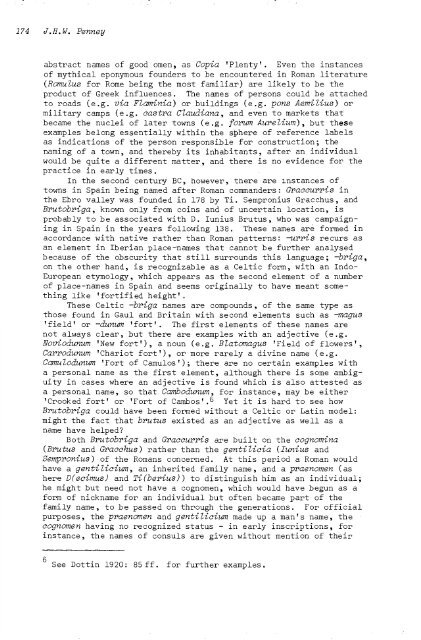CONTENTS NO.I - Institute of Social and Cultural Anthropology ...
CONTENTS NO.I - Institute of Social and Cultural Anthropology ...
CONTENTS NO.I - Institute of Social and Cultural Anthropology ...
Create successful ePaper yourself
Turn your PDF publications into a flip-book with our unique Google optimized e-Paper software.
174 J.H.W. Penney<br />
abstract names <strong>of</strong> good omen, as Copia 'Plenty'. Even the instances<br />
<strong>of</strong> mythical eponymous founders to be encountered in Roman literature<br />
(RomuZus for Rome being the most familiar) are likely to be the<br />
product <strong>of</strong> Greek influences. The names <strong>of</strong> persons could be attached<br />
to roads (e.g. via FZaminia) or buildings (e.g. pons AemiZius) or<br />
military camps (e.g. castra CZaudiana, <strong>and</strong> even to markets that<br />
became the nuclei <strong>of</strong> later towns (e.g. forum AureZium) , but these<br />
examples belong essentially within the sphere <strong>of</strong> reference labels<br />
as indications <strong>of</strong> the person responsible for construction; the<br />
naming <strong>of</strong> a town, <strong>and</strong> thereby its inhabitants, after an individual<br />
would be quite a different matter, <strong>and</strong> there is no evidence for the<br />
practice in early times.<br />
In the second century BC, however, there are lnSTances <strong>of</strong><br />
towns in Spain being named after Roman comm<strong>and</strong>ers: Graccurris in<br />
the Ebro valley was founded in 178 by Ti. Sempronius Gracchus, <strong>and</strong><br />
Brutobriga, known only from coins <strong>and</strong> <strong>of</strong> uncertain location, is<br />
probably to be associated with D. Iunius Brutus, who was campaigning<br />
in Spain in the years following 138. These names are formed in<br />
accordance with native rather than Roman patterns: -urris recurs as<br />
an element in Iberian place-names that cannot be further analysed<br />
because <strong>of</strong> the obscurity that still surrounds this language; -briga,<br />
on the other h<strong>and</strong>, is recognizable as a Celtic form, with an Indo<br />
European etymology, which appears as the second element <strong>of</strong> a number<br />
<strong>of</strong> place-names in Spain <strong>and</strong> seems originally to have meant something<br />
like 'fortified height' .<br />
These Celtic -briga names are compounds, <strong>of</strong> the same type as<br />
those found in Gaul <strong>and</strong> Britain with second elements such as -magus<br />
'field' or -dunum 'fort'. The first elements <strong>of</strong> these names are<br />
not always clear, but there are examples with an adjective (e.g.<br />
Noviodunum 'New fort'), a noun (e.g. BZatomagus 'Field <strong>of</strong> flowers',<br />
Carrodunum 'Chariot fort'), or more rarely a divine name (e.g.<br />
CamuZodunum 'Fort <strong>of</strong> Camulos'); there are no certain examples with<br />
a personal name as the first element, although there is some ambiguity<br />
in cases where an adjective is found which is also attested as<br />
a personal name, so that Cambodunum, for instance, may be either<br />
'Crooked fort' or 'Fort <strong>of</strong> Cambos'.6 Yet it is hard to see how<br />
Brutobriga could have been formed without a Celtic or Latin model:<br />
might the fact that brutus existed as an adjective as well as a<br />
name have helped?<br />
Both Brutobriga <strong>and</strong> Graccurris are built on the cognomina<br />
(Brutus <strong>and</strong> Gracchus) rather than the gentiZicia (Iunius <strong>and</strong><br />
Sempronius) <strong>of</strong> the Romans concerned. At this period a Roman would<br />
have a gentiZicium, an inherited family name, <strong>and</strong> a praenomen (as<br />
here D(ecimus) <strong>and</strong> Ti(berius) to distinguish him as an individual;<br />
he might but need not have a cognomen, which would have begun as a<br />
form <strong>of</strong> nickname for an individual but <strong>of</strong>ten became part <strong>of</strong> the<br />
family name, to be passed on through the generations. For <strong>of</strong>ficial<br />
purposes, the praenomen <strong>and</strong> gentiZicium made up a man's name, the<br />
cognomen having no recognized status - in early inscriptions, for<br />
instance, the names <strong>of</strong> consuls are given without mention <strong>of</strong> their<br />
6 See Dottin 1920: 85 ff. for further examples.

















